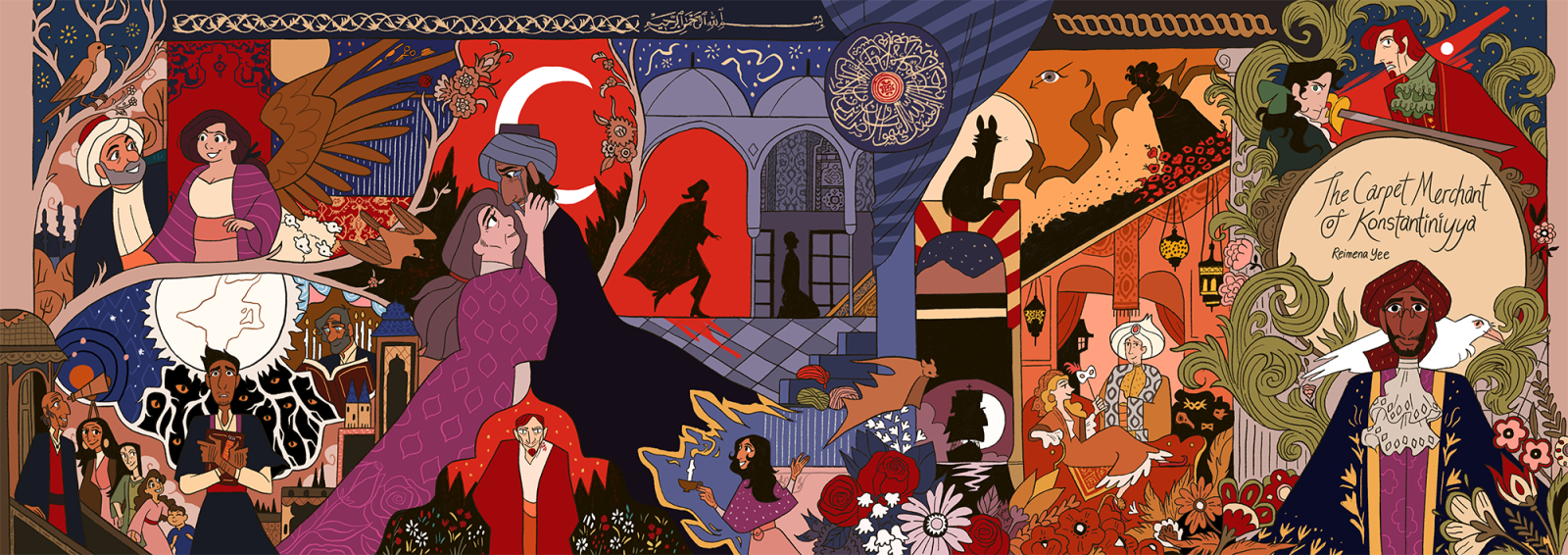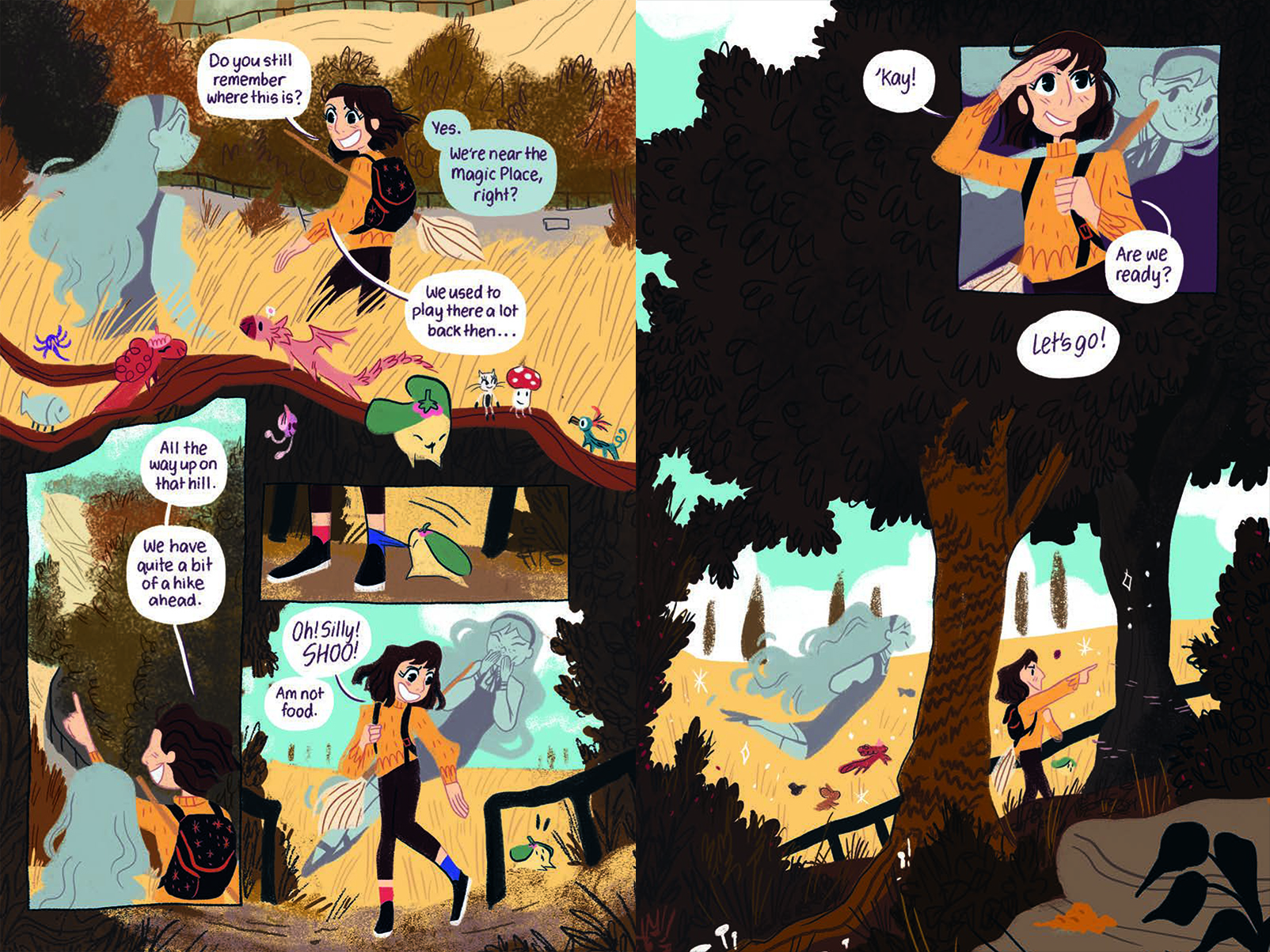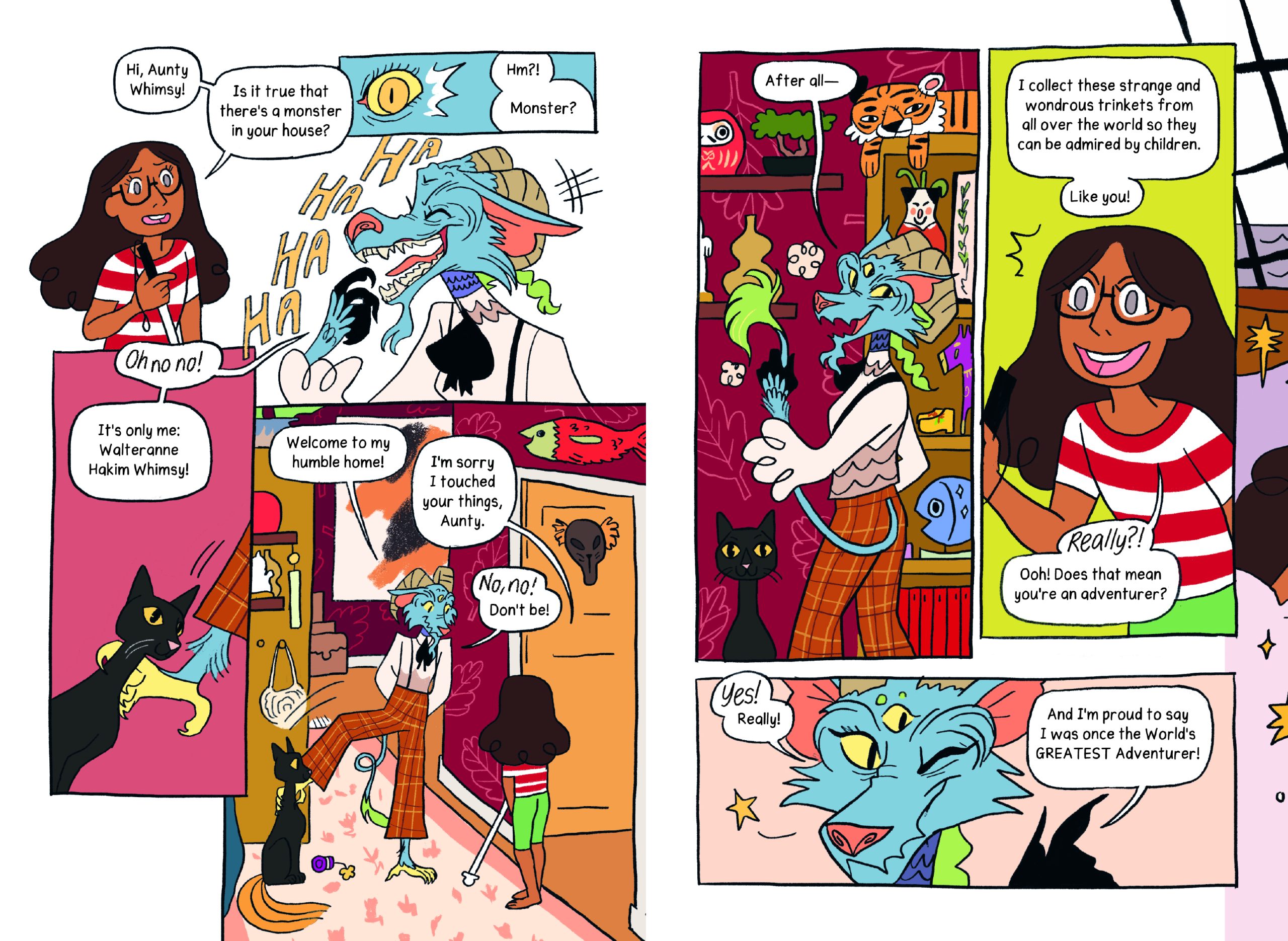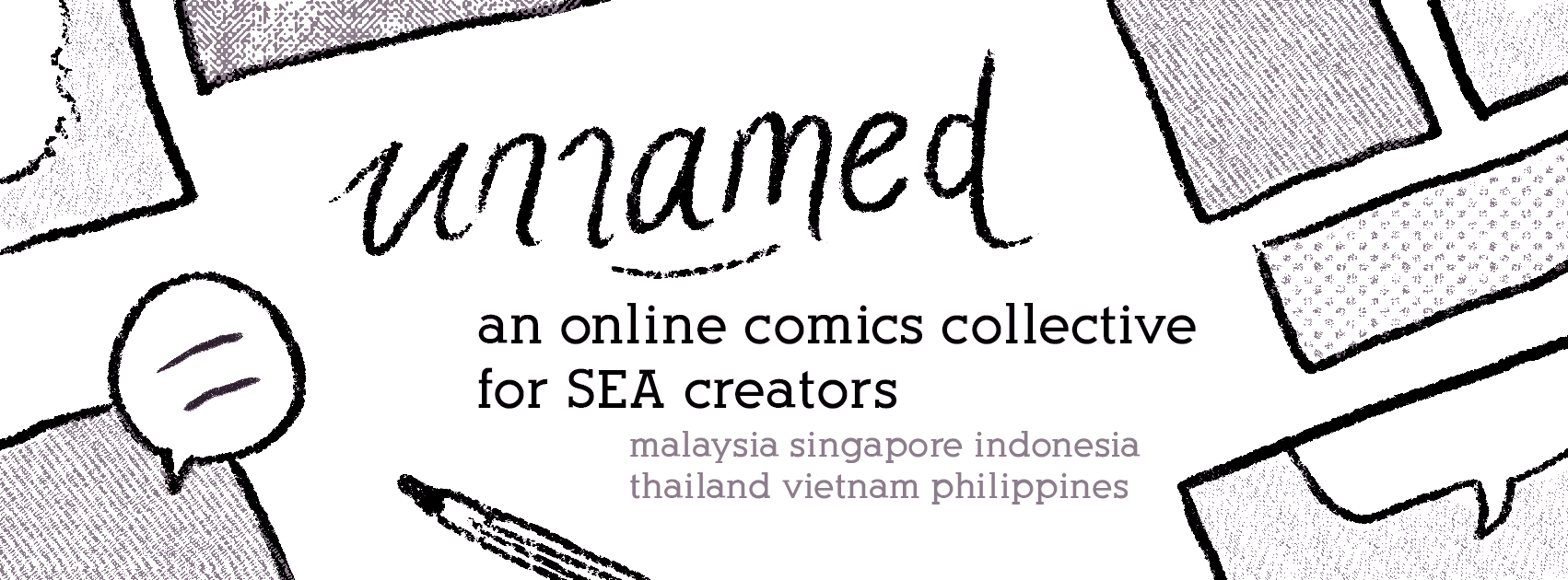
Reimena Yee’s extensive comics-making career encompasses adult comics, kids' comics, serialized webcomics, print comics and illustration. The winner of the 2022 Ignatz Award for Outstanding Artist, Yee’s webcomic Alexander, the Servant & the Water of Life has also been featured in an exhibition at the British Library. My Aunt Is a Monster, Yee’s latest graphic novel, was released this fall by Random House Graphic, and it tells a classic action-adventure story with a supernatural twist.
In this interview, Bengali/British comics creator and illustrator Shanti Rai–whose debut graphic novel about a girl discovering the true nature of her world’s gods, Sennen, was published by Avery Hill last fall–discusses gods, monsters, and comics storytelling with Reimena Yee. This interview was conducted by email, and has been edited for concision.
-The Editors
SHANTI RAI: How did you first get started with creating comics and how did that lead into creating your first graphic novel? Do you remember the first moment you thought “I’d love to create books”?
REIMENA YEE: I had always drawn and written stories since a very young age. My school exercise books were littered with stories of characters (a mix of original and borrowed characters from TV and books) bonding and going on adventures. When I was 9, I started my first long-form comic strip series, Callupish, which lasted for three years. Back then, I aspired to be a newspaper cartoonist, since what I used to read mostly back then were comics strips (Garfield, Calvin and Hobbes, Zits, etc.) and Archie Comics.
I started establishing an online presence at around 11 to 12, on Neopets.com. That introduced me to the larger community of artists from all over the world with varying skills, who shared a passion for drawing and making stories. Around that time, I was going through a transition. I was moving away from my newspaper comics ambition, instead aiming for a practical career in the sciences with a side gig as prose author.
Although I still maintained an active interest in drawing, since I always made things for the pleasure of making something exist, for self-expression and self-improvement and finding joy amidst the stress of studying... I actually wanted to be a prose writer more - someone who tells stories using only words. Despite having a knack for comics, I didn't make the connection that I could use comics to tell the super-grand, super-complex stories I suddenly wanted to write. My idea of comics at that time was all Archies and Garfield and basically, all those comics in newspapers and magazines, which were short, simple stories in a simple style. So I didn't think that comics were "big enough" to handle my writing ambitions. And for a year I separated my ambitions for drawing, and my ambitions for writing.
I discovered webcomics when I was 14: webcomics that are done by independent creators and self-published online, with nuanced stories, compelling characters, big worlds, beautiful visuals, told with both art and words. And I realized that actually, comics have always been big enough, and bigger. Just that I was looking at it from a not-so-informed-yet perspective. One thing I also realized was that all of the stories I write rely so much on imagery... and obviously, comics solves that problem.
From there, I began development and production of my first webcomic, The World in Deeper Inspection, which gradually built the foundation for the biggest break in my career and personal life: The Carpet Merchant of Konstantiniyya.
The World in Deeper Inspection is your passion project and you plan to keep working on it. What made you take a break? What draws you back?
Since its debut, The World in Deeper Inspection has always been interrupted by other things in my life: first, my schooling; then, a career making graphic novels for traditional publishing; and soon, graduate studies. The World in Deeper Inspection is set up to be a story with no obligation to anyone or anything except my own whims, so I am not bothered by its stops and starts. I do miss my characters a lot, and I'm eager to play in that whimsical, experimental, ambitious world whenever I next get the chance.
Do you have an end in mind, or is it an ongoing project that could continue indefinitely?
There is definitely an ending, but when will I get there? Who knows? That's why I need to return to it.

The Carpet Merchant of Konstantiniyya was your first foray into the historical, followed up by the ongoing epic of Alexander. When did you first decide you wanted to explore history within your graphic novels and what does the research and development process look like for you?
The Carpet Merchant is not exactly my first dabble into historical fiction - that honor goes to its parent webcomic, The World in Deeper Inspection.
I have always been a reader of historical fiction, especially ones set in the Georgian-Victorian-Edwardian period. The World in Deeper Inspection is an expression of that interest, among others: for the macabre, whimsical and artistically ambitious. The Carpet Merchant was born from that same passion. But, unlike TWIDI, The Carpet Merchant demanded so much more out of me as a young author: of responsibility, of care, and of rigor into the art I was making. I gained my current process (writing, research, art) and philosophy as a creator from that era.
I have spoken about my process in various spaces of mine: the Onion Method of Story Outline and Art Direction; How to do Research for a Graphic Novels; the FAQ of the Alexander webcomic. It's hard to distill my process into a soundbite, since it involves a lot of what I call 'stewing' - thinking, reading, resting. Generally, I have an image in my head which I expand by call-and-response debates on theme and character; once I have those nailed down, I establish an art direction that supports the story I'm making. Research is an ever-present part of the process from conception to the final colors; I do it how I learned in university, by picking up topically relevant books (sometimes unexpected ones) and making notes and finding things to build up my creative argument, similar to a thesis.
Alexander is not necessarily a hero many people know much about; I only learnt about his story in more detail through your webcomic! Where did the inspiration to create a comic series about him come from?
Haha, it wasn't that long ago when Chaucer said that everyone in the world knew about Alexander, since for most of the classical, medieval and pre-modern, he was the archetypal philosopher-hero-king. I didn't know much about him either, until I encountered Kanishk Tharoor's take on the Eastern Alexander Romance in his short story collection [Swimmer Among the Stars]. Normally I'm not interested in royalty as a subject, but I was drawn to the 2,000 years of art (artists) and story (poets and writers) that followed Alexander's death - how hundreds of creatives across time, place, and religion retold his life and legends and held him as a model of character, and how he is a mirror of the era in which these retellings are made. It's been a while since the last retelling, so I figured, why not make an Alexander Romance for the 21st century? There are some interesting things to explore in regards to Alexander's legacy about kingship, colonialism, war, and power given what happened in the last 200 years.

How did the exhibition at the British Library come about, and what was it like seeing your work displayed there?
My consultant for the webcomic, Richard Stoneman, was brought on as lead editor of the exhibition catalog, and he introduced me to two of the curators, Adrian Edwards and Yrja Thorsdottir, whom I worked with to produce an original piece. I am really happy and proud to be a part of the exhibition; it's a major life goal of mine to have my work appear in a museum or library in this manner. It's also cool to see my comic put in context alongside its predecessors.
I’m curious to know the difference in process between writing a historical graphic novel based on a famous character, and one with your own characters. Do you need to have someone else on board to make sure everything is fact-checked? Is there more pressure when you’re writing?
For me, it makes no difference if it's a known figure or an original character in a historical setting - both require the same effort, thought and rigor (though there is definitely more creative flexibility for an original character).
The Alexander webcomic is the first time I actually brought on a consultant - given the complexity and variety of Alexander's legacy, Richard's 40 years in the field is valuable. Now, I wouldn't say it's necessary to get a fact-checker or expert for every project, but it's always worth it to reach out. Scholars are very happy to be a part of the process.
When I am writing, my goal is not to aim for accuracy, but to create atmosphere and characters that feel lived-in and plausible. So beyond the requirements of making a good comic, I don't feel any additional pressure to make something perfectly accurate or factually invincible - that sort of thing is not 100% possible even within history as a subject matter anyway. What's more important is that you have an interpretation, and ensure that interpretation has academic backing and has gone through a process of interrogation for biases and misconceptions. Everything else is craft.
Often within the pages of both Carpet Merchant and Alexander, you use motifs and imagery from medieval and ancient art. Do you think drawing and researching historical art has had an influence on your style?
It's given me more of a visual vocabulary to work with. I am always pleased to see how similar my cartooning is to the flatter, stylised art of pre-modern historical art (whether that's a good or bad thing, I can't say). If historical art has influenced me, I've included more decorative flourishes in my illustrations.

You’re an editor at Hiveworks, a platform for webcomics where Alexander was first published. What makes you decide between a webcomic format or a more traditional physical book? Do you think different formats can offer different things?
Well, Alexander is made for both the webcomic and traditional page format. The only reason why it's a webcomic first is because there was no offer from traditional publishers due to the pitch's high risk (it's a historical multi-book epic for adults) compared to what is marketable right now in the graphic novel space. But even if it got a book deal, it would still be very important for me to release it simultaneously as a webcomic regardless. I wanted the work to be accessible, plus the story benefited from having its own website where the reader can immerse themselves in the context of its history, via the author's notes, the footnotes, hyperlinks and the miscellaneous content - additional material which is not possible to include in a physical book due to constraints. I realized The Carpet Merchant was successful and highly-regarded in large part due to its accessibility and my openness to share the research, so that's become the "winning formula" I use for my historical work.
I am pragmatic, so I think certain stories are fit for certain distribution modes or formats depending on goals, market realities, creative voice, etc. I'm mostly agnostic on distribution as the driving force for publishing a comic - the final decision must always come down to what both story and author need to thrive.

Talk a little about Séance Tea Party! What was it like to make your first middle grade book?
I was very lucky to be working with Whitney Leopard at Random House Graphic. Whitney, coincidentally, handled my first paid client commission ever in 2013-2014, which was a full circle moment for me personally. Anyway, making Séance Tea Party wasn't all that different from making The Carpet Merchant of Konstantiniyya, as I personally don't draw a line between middle grade or adult storytelling. The only thing different was that I had to actively consider audience and presentation - when you're making a comic for yourself, you don't think all too much about whether the reader (or the market) understands your material. Fortunately, Whitney is experienced and capable of understanding my scribblings and vague scripts.
My Aunt Is a Monster is a fantastic story, packed with gorgeous illustration that was a joy to read. You’ve mentioned that it was originally a comedic adventure for adults, inspired by Alexander McCall Smith's Professor Dr. von Igelfeld novels. The story has been translated over fantastically to suit a younger audience but maintains the appeal for adult readers (like me!) with its wry sense of humor. Did you struggle with changing the direction of the story, or did you find it naturally coming together?
My Aunt was a Monster was always meant to be an all-ages story - it's just that the focus shifted from Aunty Whimsy to Safia as a point-of-view character. I actually struggled with writing My Aunt is a Monster when it was originally in the adult POV - I somehow never got past the scene of Whimsy reading the newspaper. When Safia took on the POV, I finally defeated that years-long obstacle, since there was now the additional emotional motivation for the three main characters. Other than the POV shift, the story's more-or-less the same: I didn't compromise the prominent presence of the adults, nor change their behavior.
How did you settle on Safia as the main character and how did her design evolve over the creation process?
Safia has been part of the cast since the early days of the story. As mentioned before, the story was originally written in the POV of the adult main character before it shifted, due to having found a home with a children's publisher. Safia's design was easy: she arrived from my head to paper in one take.

As a disabled comics creator, it was so lovely to see the main character’s being blind not treated as an obstacle or a barrier to her becoming a fearless adventurer! The cast in general feels very diverse in the best way. Is it important to you to be inclusive in your work?
There's no need for me to actively pursue "inclusion" since the world I live in is already chock-full of very interesting, very different, very strange people. And the world is where I get my ideas from. I don't think it's important to feature diversity as something noteworthy since all it really is is simply a mundane reflection of life, and should be treated as such.
The themes of family, friendship, and adventure are strong in your comics. Are there any places you’d love to adventure to? Who and what would you take with you?
I'd love to go see as much of the world as possible. I usually travel solo, but I would love to take my close friends (any of them) on trips.
It’s so interesting seeing your drawing process at the end of My Aunt Is a Monster, especially how quickly you go from initial idea to end novel! How do you stop from getting drawing burnout?
I am very familiar with my process and confident in my limits, so I tend to pace myself based on my physical and mental needs at the moment. I eat meals regularly. I rest. I get eight hours of sleep. If I feel queasy or any amount of sting in my wrist, I stop. I never pressure myself to make anything because that never draws out energy or motivation within me, and I relish the quiet periods where I am not producing anything. Taking care of myself has worked: although I do feel an exhaustion that comes from finishing a project, I'm still excited to keep making more - which is the goal because I am here for the long-term.
At what point did you decide that comic making would now be your primary focus and source of income / step away from the world of science?
I had a quarter-life crisis sometime during my penultimate year of undergraduate studies - after realizing how incompatible I was to that particular future I was studying for. The only other thing I was good at was art and story, so I hustled to get an agent, get a book deal for The Carpet Merchant, gain some kind of recognition to avoid being a disappointment to my family. Fortunately a series of lucky breaks and opportunities–aided by TCM–happened as I graduated.
What are the best and worst parts of working on a graphic novel for you, and do you have any tips or tricks you would share with budding novelists?
Graphic novels are rich and fulfilling as a storytelling medium, but I wish they weren't so consuming and so dependent on me being in one place, one mindset. If there was a way to leave my comics-creating self at home while the other parts of me experience globe-trotting, food-eating and book-reading, I'd be satisfied.
The advice I always give to young creators is to take care of your mind and body: this means three meals, sleep eight hours, rest constantly, having other hobbies and protecting yourself from injuries. The entire point of being in comics is to be here for a long time: I imagine myself as a gray-haired grandma with a proud and varied body of work - so I live accordingly in anticipation of that future.
You’ve done lots of work in Malaysia amplifying the work of SEA comics creators, including co-founding the unnamed collective. How did that come about and what positive impacts are you seeing from your projects?
unnamed was established to be a networking hub of knowledge and resource-sharing, since back then it was a struggle to find comics advice and resources specific to Southeast Asian reality. It was primarily a digital collective, but over time it has expanded to in-person activities like panels, workshops, art jams and representation at comics festivals. I'm most proud of unnamed making it an easier time for the younger generation to get into comics and find each other.
Do you ever take inspiration from your Malaysian heritage for aspects of your stories? If there was one Malaysian myth or historical figure you could write a novel about, who/what would it be?
So far, I've completely avoided showing my Malaysianness in any part of my stories published so far. I do have three pitches in my head: a silent comic about an old uncle and a motorcycle bread vendor; a Kuala Lumpur quarter-life crisis slice-of-life; and a spooky comedy young adult set during the Hungry Ghost Festival. With my Malaysian stories, I am more interested in the idiosyncrasies and run-down nostalgia that's part and parcel of the contemporary urban experience, so I don't have any affinity for a historical or mythical figure at home.
Are there any SEA creators you’d like to shine a spotlight on, or anything you’ve particularly enjoyed reading lately?
Check out these creators: Charis Loke, Maya Schmidt, Rob Cham, Fishball (of My Giant Nerd Boyfriend fame), Tuan Nini, Nadhir Nor.
And these publishers: Difference Engine, Komik Maple, Adarna House, PICOF/Komiket.
And finally, are there any ideas that you have floating around in your head right now that you’re desperate to start working on? What can we expect to see from you next? I for one am anticipating all there is to come.
I'm still stuck with Alexander for the foreseeable future, but I have a young adult romantic comedy coming soon, and some other autobio-related ideas. I also want to return to The World in Deeper Inspection and devote the rest of my time to finishing it.
The post “The Entire Point Of Being In Comics Is To Be Here For A Long Time”: An Interview with Reimena Yee appeared first on The Comics Journal.


No comments:
Post a Comment